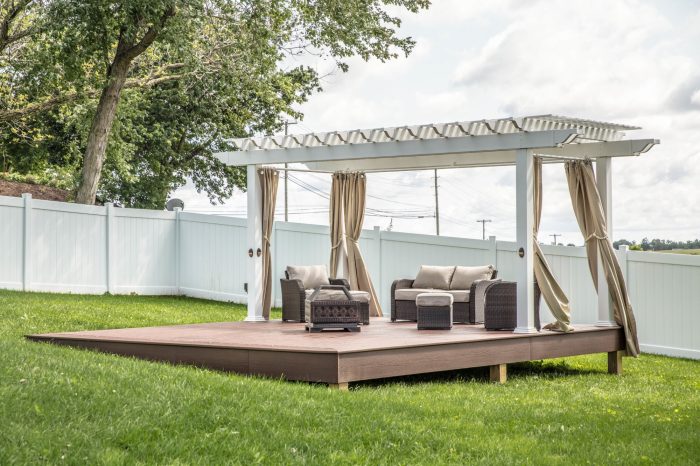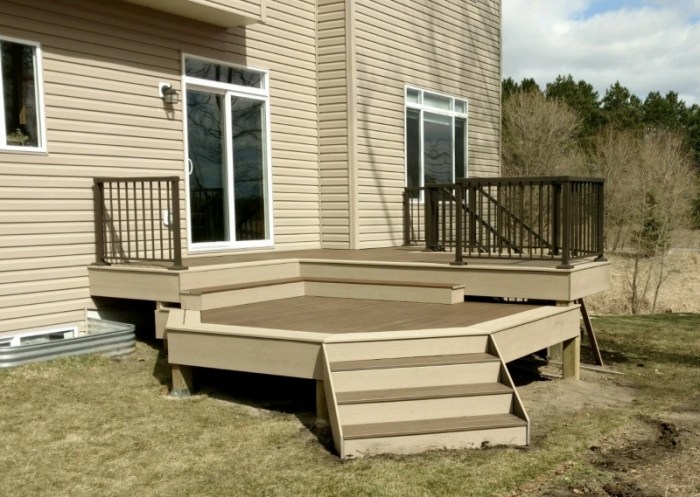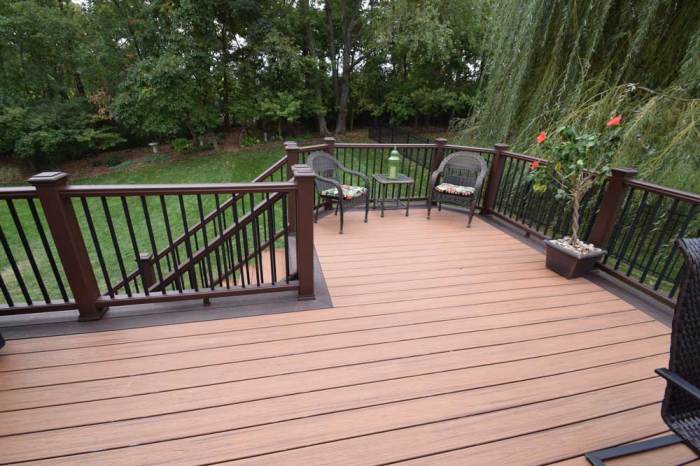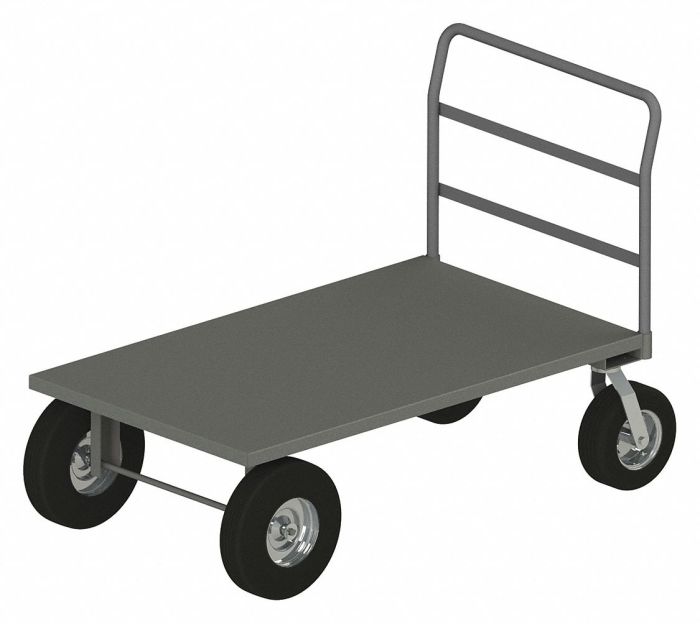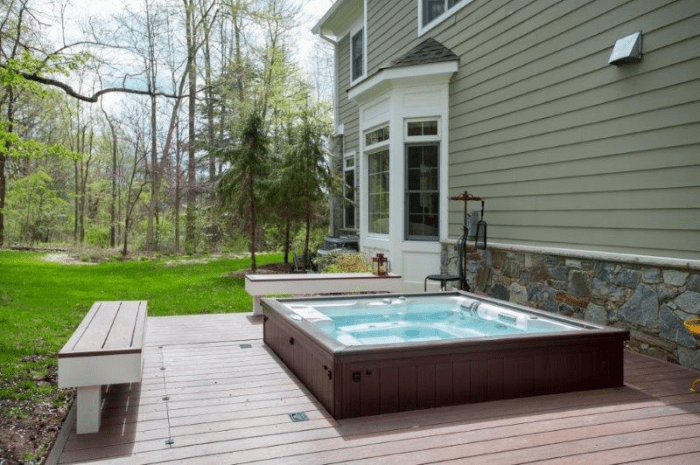Platform Deck for Hot Tub Design & Build Guide
Platform deck for hot tub: A well-designed platform deck significantly enhances your hot tub experience. From material selection to safety considerations, this guide provides a comprehensive overview of everything you need to know to create a stunning and functional space around your hot tub.
This guide explores various types of hot tub platform decks, including freestanding, integrated, and modular options. Different materials, like wood, composite, and concrete, are examined, along with the pros and cons of each. We’ll also delve into design considerations, construction methods, maintenance requirements, and budget-friendly solutions, making sure your hot tub deck meets both your aesthetic and functional needs.
Introduction to Hot Tub Platform Decks
A hot tub platform deck is a specialized structure designed to safely and aesthetically integrate a hot tub into an outdoor living space. It provides a stable and accessible platform for enjoying the hot tub, extending the usable area, and enhancing the overall outdoor experience. This structure is more than just a simple surface; it’s a critical element in creating a harmonious blend of functionality and design.
These decks are constructed to withstand the weight of the hot tub, as well as the anticipated usage patterns, and are often built with considerations for safety, accessibility, and longevity. The choice of materials and design elements directly impacts the performance, safety, and appearance of the entire setup.
Materials Commonly Used
The selection of materials for hot tub platform decks significantly impacts the deck’s durability, maintenance requirements, and aesthetic appeal. Common choices include composite decking, pressure-treated lumber, and concrete.
- Composite decking is a popular choice due to its resistance to rot, decay, and insect infestations. It requires minimal maintenance, offering a low-cost solution in the long run, and comes in a variety of colors and textures.
- Pressure-treated lumber, while more susceptible to moisture damage than composite, is a cost-effective option if properly maintained. Regular sealing and staining are essential to prolong its lifespan. It provides a natural aesthetic that complements many outdoor settings.
- Concrete offers a robust and durable platform, capable of withstanding substantial weight and enduring harsh weather conditions. However, concrete decks often require more extensive construction and may be more expensive than other options.
Styles and Designs
A variety of styles and designs are available to suit different aesthetic preferences and functional requirements. Factors like the surrounding landscape, existing architecture, and personal taste all play a role in determining the best fit.
- Contemporary designs often feature clean lines, minimalist aesthetics, and a focus on functionality. They frequently incorporate sleek railings and modern materials like composite decking.
- Traditional designs might incorporate classic architectural elements, such as columns, arches, or decorative railings, often using wood or stone materials. They tend to blend seamlessly with established outdoor spaces.
- Transitional designs aim to bridge the gap between modern and traditional styles, integrating contemporary elements into a classic aesthetic. This approach provides a balance of visual appeal and practical considerations.
Safety Considerations in Design
Proper platform deck design is paramount for hot tub safety. Careful planning and construction are essential for preventing accidents and ensuring a secure and enjoyable experience.
- Slip-resistant surfaces are crucial to prevent falls, particularly around the hot tub area. This often involves using materials with textured finishes or specialized coatings.
- Adequate handrails and guardrails are vital for stability and safety, particularly for users of differing heights and mobility levels. They should be sturdy and easy to grasp, with appropriate spacing and heights.
- Clearance around the hot tub is essential for easy access and egress. Sufficient space should be maintained to prevent collisions and allow for safe movement around the unit.
Enhancing Aesthetic Appeal, Platform deck for hot tub
Hot tub platform decks can dramatically enhance the aesthetic appeal of outdoor spaces. They provide a visually appealing transition between indoor and outdoor living areas, adding a touch of sophistication and luxury to the environment.
- Careful selection of materials and finishes can create a unified look that complements the existing landscaping and architectural style. For example, using a light-colored deck can brighten a shaded area, while dark colors can add a sense of drama.
- Integrating the deck with surrounding landscaping, such as incorporating vegetation or water features, can further enhance the overall aesthetic. Landscaping design can effectively draw the eye and create a more inviting and relaxing ambiance.
- The placement of the deck about other outdoor structures, like patios or gazebos, can create a cohesive and visually appealing outdoor living space.
Types and Features of Platform Decks
Platform decks provide a crucial extension of your hot tub experience, seamlessly blending the relaxation of the tub with the comfort and aesthetic appeal of an outdoor living space. Properly designed and constructed, they enhance your enjoyment and safety while also adding value to your property. Choosing the right type of platform deck is essential, considering factors like your budget, desired aesthetics, and the overall space around your hot tub.
Different platform deck types cater to various needs and preferences. Each offers unique advantages and disadvantages, requiring careful consideration of your specific requirements. This section delves into the various options, highlighting the key features, materials, and potential benefits of each type.
Freestanding Platform Decks
Freestanding platform decks are independent structures, often built on concrete pads or other stable foundations. They offer the most flexibility in placement and design, allowing you to customize the layout to match your existing landscape. They can be integrated with existing structures, but they are self-contained units.
- Common materials include pressure-treated lumber, composite materials like PVC or WPC, and concrete. Pressure-treated lumber provides a classic, natural look but requires more maintenance. Composite materials offer a low-maintenance alternative, resisting rot and insect damage. Concrete is a durable and long-lasting option, providing a substantial platform that’s resistant to weather elements.
- Key features of freestanding decks include customization options, easy installation, and adaptability to various terrains. Proper anchoring and foundation are critical for stability and safety.
Integrated Platform Decks
Integrated decks are part of a larger structure, like a patio or gazebo. They seamlessly blend into the overall design, enhancing the aesthetic harmony of your outdoor space. They typically require more planning and coordination with your existing construction.
- Materials used often include the same materials as freestanding decks, but the design considerations are influenced by the integration with the surrounding structure. The choice of materials might also be influenced by the prevailing aesthetic and structural integrity of the overall design.
- Integrated decks often come with built-in features like benches, railings, and lighting, adding to the overall functionality and sophistication of the area.
Modular Platform Decks
Modular decks consist of pre-fabricated sections that are assembled on-site. They offer a fast and efficient installation process, ideal for those seeking a quick solution. They are available in various sizes and styles to fit specific hot tub requirements.
- Common materials include composite materials, which are designed for low-maintenance upkeep. These materials often offer a range of colors and textures to suit your preferences.
- Modular decks are often easier to install than custom-built decks. Pre-cut sections and standardized designs streamline the assembly process.
Durability and Weather Resistance
Durability and weather resistance are paramount for hot tub platform decks. Exposure to the elements, including rain, snow, and UV rays, can significantly impact the lifespan of the deck.
- Selecting materials resistant to rot, mold, and mildew is essential. Composite materials, for instance, are known for their resistance to these issues. Proper sealing and maintenance also play a crucial role in extending the deck’s lifespan.
Comparison of Deck Types
| Deck Type | Materials | Features | Pros | Cons |
|---|---|---|---|---|
| Freestanding | Wood, composite, and concrete | Customizable, adaptable to various terrains | Flexibility, tailored design | Potentially higher installation costs |
| Integrated | Wood, composite, and concrete | Seamless integration with existing structures | Aesthetically pleasing, enhanced outdoor living space | Limited design customization, potential coordination issues |
| Modular | Composite | Pre-fabricated sections, fast installation | Efficiency, quick assembly | Limited customization, potential design constraints |
Design Considerations for Hot Tub Platform Decks
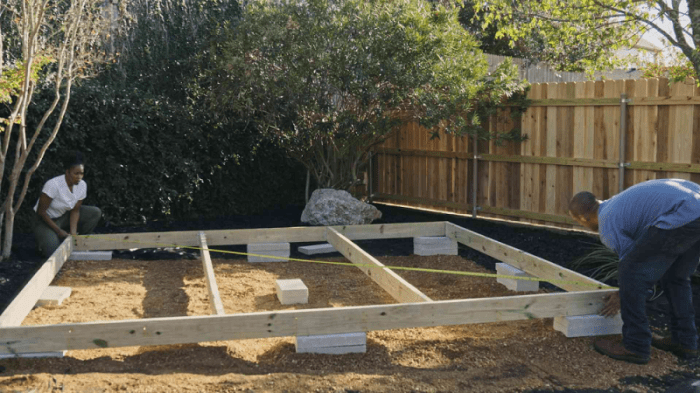
Source: byrossi.com
Designing a hot tub platform deck involves careful consideration of safety, aesthetics, and functionality. A well-designed deck enhances the enjoyment of the hot tub and seamlessly integrates with the surrounding landscape. Key elements like accessibility, lighting, and seating areas should be thoughtfully planned.
A successful hot tub platform deck prioritizes user safety and comfort. This involves careful planning of the deck’s structural integrity, material choices, and accessibility features. The design should be not only aesthetically pleasing but also practical, allowing for easy access to and from the hot tub.
Safety and Structural Integrity
Ensuring the deck’s structural stability is paramount. The deck must be capable of supporting the weight of the hot tub, users, and any additional features like seating or lighting. Materials like treated lumber, composite decking, or concrete are suitable options, depending on the specific needs and aesthetic preferences. Proper drainage and slope to prevent water accumulation are critical for preventing slip hazards. Compliance with local building codes and safety standards is essential for legal and safety reasons.
Accessibility and Usability
Designing for accessibility is crucial for all users. Sufficient space around the hot tub allows for comfortable entry and exit, even for individuals with mobility limitations. Ramped access or steps with appropriate handrails are beneficial for easier movement. Consider the location of electrical outlets and switches for convenient operation of lighting and other features. The deck should be designed with the needs of all users in mind.
Integration with the Landscape
Careful integration with the surrounding landscape enhances the aesthetic appeal of the deck. Matching the deck’s materials and colours to the existing landscaping features creates a harmonious blend. Consider the natural contours of the yard, integrating the deck’s design to enhance the existing view. Using natural materials like stone or wood can blend the deck with the surroundings seamlessly. Appropriate landscaping around the deck, such as plants and shrubs, adds beauty and privacy.
Lighting and Seating Areas
Lighting enhances the ambiance and safety of the deck, particularly during evening use. Strategically placed lights around the hot tub and deck create a welcoming atmosphere. Consider using LED lighting for energy efficiency and long-lasting performance. Seating areas, whether benches, chairs, or lounge areas, should be incorporated into the design. These should be comfortable, durable, and complement the overall aesthetic. The seating areas should be located for optimal relaxation and enjoyment.
Deck Dimensions Based on Hot Tub Size and User Capacity
| Hot Tub Size | User Capacity | Minimum Deck Dimensions | Optional Features |
|---|---|---|---|
| Small (e.g., 6-person) | 6 | 8ft x 10ft | Small bench seating, pathway lighting |
| Medium (e.g., 8-person) | 8 | 10ft x 12ft | Larger seating area, integrated fire pit |
| Large (e.g., 10-person) | 10+ | 12ft x 14ft | Outdoor kitchen, pergola, shade structure |
Note: These dimensions are guidelines. Actual dimensions may vary based on specific hot tub models, user needs, and local regulations.
Construction and Installation of Platform Decks: Platform Deck For Hot Tub
Constructing a hot tub platform deck requires careful planning and execution to ensure structural integrity, safety, and longevity. Proper consideration of drainage, waterproofing, and material selection is crucial for a successful and enjoyable addition to your property. The platform’s design should complement the surrounding landscaping and integrate seamlessly with the hot tub itself.
A well-built platform deck not only enhances the aesthetics of the hot tub area but also provides a safe and comfortable space for relaxation and enjoyment. This involves precise planning, suitable materials, and a thorough installation process. Careful attention to detail throughout the construction process will yield a high-quality platform that will serve as a reliable and aesthetically pleasing addition for many years.
Step-by-Step Construction Procedure for a Basic Platform Deck
This procedure articulates the key steps for constructing a basic hot tub platform deck. Precise measurements and adherence to local building codes are paramount.
- Site Preparation: Thoroughly clear the designated area of debris, vegetation, and any existing structures. Level the ground using appropriate tools and techniques to ensure a stable foundation for the platform.
- Framing: Construct the platform’s framework using pressure-treated lumber or other suitable materials. Ensure proper support beams and joists are installed according to the platform’s design. The dimensions of the framing should accurately match the deck’s intended size and shape.
- Decking: Install the decking material (e.g., composite, wood, or concrete) over the framing. Ensure proper spacing and secure the decking boards using appropriate fasteners. This stage involves precise placement and fastening to maintain structural integrity and aesthetic appeal.
- Drainage and Waterproofing: Install a proper drainage system to prevent water accumulation. This could include installing gutters, downspouts, or a French drain. Waterproofing the deck is crucial to protect it from moisture damage, using waterproof membranes or sealants to prevent water penetration.
- Finishing Touches: Add any necessary finishing touches, such as railings, handrails, or other safety features. Ensure all surfaces are smooth and free of sharp edges to create a safe environment.
Importance of Proper Drainage and Waterproofing
Adequate drainage and waterproofing are critical for preventing water damage and ensuring the longevity of the platform deck. Water accumulation can lead to rot, mildew, and structural weakening over time.
Proper drainage directs rainwater and melted snow away from the deck, preventing water from pooling and seeping into the structure. This involves careful planning during the installation phase, incorporating elements like sloped surfaces and efficient drainage systems. Waterproofing the deck prevents water from penetrating the decking material, protecting it from moisture damage. This often involves applying waterproof membranes or sealants to the decking surfaces and using waterproof fasteners for the support structures.
Installation Methods for Different Materials
The choice of installation method depends heavily on the material selected for the platform deck.
- Wood Decking: Wood decking requires careful treatment to prevent rot and insect damage. Properly treated lumber is essential for longevity. Fasteners, such as screws or nails, should be appropriate for the wood type and thickness. Install the boards with proper spacing and secure them using appropriate techniques to prevent gaps and ensure structural integrity.
- Composite Decking: Composite decking is relatively low-maintenance and resistant to rot and insects. Installation involves attaching the composite boards to the framework using specific fasteners designed for composite materials. Carefully follow the manufacturer’s instructions for proper installation.
- Concrete Decking: Concrete decking offers a durable and long-lasting option. Pouring or installing concrete slabs requires careful formwork and proper curing. Ensuring proper drainage and waterproofing is crucial for preventing moisture-related issues. Proper concrete preparation and curing are essential for the long-term integrity of the deck.
Safety Features in Hot Tub Platform Decks
Safety should be paramount in the design and construction of hot tub platform decks.
- Handrails and Guardrails: Installing handrails and guardrails around the platform edges is crucial for preventing falls, particularly for those entering or exiting the hot tub. The design and placement of handrails and guardrails must comply with local building codes.
- Non-Slip Surfaces: Using non-slip materials for the decking surface helps prevent slips and falls, especially when the deck is wet. This is particularly important around the hot tub area.
- Proper Lighting: Adequate lighting around the platform, including pathways and steps, is vital for safety, especially at night. This enhances visibility and reduces the risk of accidents.
Deck Support Systems
Choosing the right support system is essential for a sturdy and long-lasting platform deck.
| Support System | Materials | Pros | Cons | Installation Steps |
|---|---|---|---|---|
| Post-and-Beam System | Pressure-treated lumber, concrete | Strong, customizable, relatively affordable | It can be prone to rot if not properly treated, and can be visually less appealing. | Dig post holes, install posts, add beams, and attach decking |
| Rafter System | Pressure-treated lumber, steel | Strong, supports larger areas, suitable for complex designs | More complex installation, potentially higher cost | Construct rafters, add support beams, and install decking |
| Decking Joist System | Pressure-treated lumber, composite beams | Simple, cost-effective, good for smaller platforms | May not support as much weight as other systems, susceptible to moisture damage | Install joists, attach decking boards |
Maintenance and Safety of Platform Decks
Proper maintenance and safety measures are crucial for the longevity and safe use of hot tub platform decks. Neglecting these aspects can lead to structural damage, safety hazards, and even injury. A well-maintained platform deck ensures the enjoyment of your hot tub for years to come.
Regular maintenance and inspections are key to preventing issues and maintaining a safe environment. Addressing potential hazards proactively will minimize risks and ensure the safety of users. A well-designed platform deck incorporates slip-resistant surfaces to enhance user safety.
Maintenance Procedures for Different Materials
Various materials are used in hot tub platform decks, each requiring specific maintenance routines. Understanding these procedures ensures the deck’s longevity and aesthetic appeal. Different materials react differently to weathering and exposure, necessitating specific maintenance approaches.
- Wood Decks: Regular cleaning with mild soap and water is essential. Inspect for signs of rot or insect infestation. Apply sealant or stain regularly to prevent water damage and maintain the wood’s appearance. Pressure washing can be used to remove dirt and debris, but avoid excessive pressure to prevent damage to the wood’s structure. Periodic structural assessments for signs of weakness are necessary. Properly maintain the fasteners and connections to prevent loosening and damage.
- Composite Decks: Composite decks are generally low-maintenance. Cleaning with mild detergent and water is sufficient. Avoid harsh chemicals or abrasive cleaners that could damage the surface. Regular inspections for any signs of damage or discoloration are essential. Thorough inspection of screws and fasteners is vital for long-term stability.
- Concrete Decks: Concrete decks require regular cleaning to remove dirt and grime. Inspect for cracks or damage to the surface. Sealants can be applied to prevent water penetration and maintain the surface’s integrity. Ensure proper drainage to prevent water accumulation and potential damage.
Importance of Regular Inspections for Structural Integrity
Regular inspections are vital for identifying potential structural issues early. Prompt identification and resolution of problems prevent catastrophic failures. Early detection and repair prevent larger and more costly problems in the future.
- Visual Inspection: Regularly examine the deck for any signs of damage, such as cracks, splintering, or loose fasteners. Look for any evidence of water damage, such as discoloration or warping. Inspect for signs of corrosion on metal components.
- Load Testing: Periodically, assess the deck’s ability to support the anticipated load. This involves carefully monitoring the deck for signs of deflection or movement under weight. Employing trained professionals for thorough load testing can prevent potential risks.
- Professional Inspections: Engage qualified contractors for professional inspections at least annually. They can provide expert assessments of the deck’s structural integrity and identify any potential issues. This professional evaluation is an essential component of the overall safety and maintenance strategy.
Addressing Potential Safety Hazards
Addressing potential safety hazards is crucial for preventing accidents. Proactive measures mitigate risks and promote a safe environment for users. Understanding the potential hazards associated with the deck is essential for minimizing risks.
- Slip Resistance: Ensure the deck surface provides adequate slip resistance. Use materials with a textured surface or non-slip coatings to prevent slips and falls, especially when wet. Regular maintenance of the deck’s surface, including the cleaning of any build-up of grime or debris, ensures the best possible slip resistance.
- Handrails and Guardrails: Install appropriate handrails and guardrails to prevent falls, especially around steps or elevated areas. Ensuring the secure attachment of handrails and guardrails is essential to their safety function.
- Lighting: Ensure adequate lighting, especially at night or in poorly lit areas. Good lighting minimizes the risk of tripping or falling in low-light conditions. This also makes for a more enjoyable and safe experience.
Significance of Proper Slip Resistance
Proper slip resistance is critical for user safety, especially in wet conditions. A slip-resistant surface is essential for preventing falls, which can lead to injuries. Slip resistance is crucial to preventing accidents in wet conditions.
- Material Selection: Choose materials with a textured surface or non-slip coatings. Examples include materials with rough surfaces, patterns, or coatings specifically designed for slip resistance.
- Maintenance: Regular cleaning to remove debris and moisture will help maintain the slip resistance of the surface. Prevent the buildup of dirt or debris, which can affect slip resistance.
Maintenance Schedule
| Material | Frequency | Procedures | Tools |
|---|---|---|---|
| Wood | Monthly | Cleaning, inspection for rot, insect damage, and sealant application | Mild soap, water, brush, sealant, screwdriver |
| Composite | Quarterly | Cleaning, inspection for damage, and fastener checks | Mild detergent, water, a brush, and a screwdriver |
| Concrete | Semi-annually | Cleaning, crack inspection, sealant application, drainage check | Detergent, water, brush, sealant, pressure washer (if necessary) |
Aesthetic Enhancements and Accessories
Transforming a simple hot tub platform deck into a captivating outdoor oasis involves careful consideration of aesthetics and the integration of thoughtful accessories. This section explores various methods for enhancing the visual appeal of your platform deck, incorporating it seamlessly into the surrounding landscape, and creating a relaxing and private sanctuary.
A well-designed platform deck, beyond its functionality, can significantly enhance the overall beauty and enjoyment of your outdoor space. Careful attention to details, such as lighting, railings, and seating arrangements, can elevate the aesthetic appeal and create a unique atmosphere. Integrating privacy features into the design ensures comfort and relaxation for all users.
Enhancing Visual Appeal
Aesthetics are paramount when creating an inviting hot tub platform deck. Careful selection of materials, colors, and textures can transform a simple structure into a focal point of your outdoor living area. Matching the deck’s style to the surrounding landscape, including the home’s architecture and existing vegetation, is crucial for a harmonious integration. For example, a natural stone deck blends seamlessly with a wooded area, while a contemporary deck design might complement a modern home.
Incorporating Accessories
Accessories are key elements in enhancing the aesthetic and functionality of a hot tub platform deck. Railings, lighting, and seating options contribute significantly to the overall design.
- Railings: Choosing the right railing style is important for both safety and visual appeal. Options range from simple, sleek metal railings to ornate wood designs. The selection should align with the overall design theme and complement the materials used in the deck construction. For example, a wrought iron railing adds a touch of elegance to a traditional-style deck, while a modern cable railing enhances a contemporary setting.
- Lighting: Strategically placed lighting fixtures can create a warm and inviting ambiance, particularly at night. Consider a combination of ambient and accent lighting to highlight architectural features and enhance the deck’s overall aesthetic. Examples include pathway lighting to guide users or spotlights to highlight specific plants or architectural elements.
- Seating: Comfortable seating options, such as benches or chairs, enhance the usability and aesthetic appeal of the deck. Choosing seating materials that match the deck’s overall design will create a cohesive and visually pleasing space. Integrating seating into the design allows users to relax and enjoy the surrounding scenery.
Integrating with the Landscape
The platform deck should seamlessly integrate with the surrounding landscape, creating a unified and aesthetically pleasing outdoor space. Matching the deck’s materials, colors, and textures with the surrounding vegetation and architecture is essential for a cohesive design.
- Matching Colors and Textures: Employing colors and textures that complement the existing landscape enhances the overall visual appeal. For example, using light-colored decking materials in a landscape with abundant greenery can create a visually balanced space.
- Placement and Orientation: The placement of the platform deck should consider the natural flow of the surrounding landscape. Strategically placing the deck to take advantage of views or natural features can enhance its aesthetic appeal.
- Planting Considerations: Incorporating strategically placed plants can complement the deck’s design and enhance the surrounding environment. For instance, choosing plants with complementary colors or textures can create a harmonious blend.
Creating Privacy
Privacy is crucial for a relaxing hot tub experience. Various design elements can help create a secluded and private area on the platform deck.
- Screening Options: Consider incorporating screens, such as hedges or trellises, to block unwanted views from neighbors or passersby. For instance, a strategically placed hedge can provide a sense of privacy while maintaining a connection with the surrounding landscape.
- Landscaping Features: Landscaping can also contribute to privacy by creating visual barriers. Tall shrubs or trees can act as natural screens, providing a sense of seclusion without compromising the aesthetic appeal of the area.
Lighting Options
The table below lists Artikels’ different lighting options for hot tub platform decks, considering features, installation, and aesthetic appeal.
| Lighting Type | Features | Installation | Aesthetic Appeal |
|---|---|---|---|
| LED String Lights | Energy-efficient, versatile, and creates a warm ambiance | Easy to install, can be draped or mounted | Creates a soft, inviting glow, suitable for various styles |
| Solar Pathway Lights | Eco-friendly, low maintenance, requires no electrical connection | Easy to install, simply place in the ground | Adds a touch of elegance and guides pathways, creating a warm, inviting feel |
| Recessed Spotlights | Highlights architectural features, adds dramatic effect | Requires professional installation, involves cutting into the deck | Creates a modern, stylish look, enhances the visual appeal of the platform |
| Ambient Landscape Lighting | Creates a serene, diffused glow over the entire area | Requires careful placement of fixtures | Creates a relaxing atmosphere, complements the surrounding landscape |
Budget Considerations for Hot Tub Platform Decks
Planning a hot tub platform deck requires careful consideration of budget constraints. Different materials, sizes, and features directly impact the overall cost. Understanding these factors allows for informed decisions and the creation of a deck that meets both aesthetic and financial goals.
A well-planned budget for a hot tub platform deck allows for informed choices about materials, size, and features. This ensures a balanced approach that delivers a desirable outcome without exceeding financial limitations. It’s crucial to establish a realistic budget at the outset to guide the design and construction process.
Budget Options for Different Platform Deck Types
Various platform deck types, from simple to elaborate designs, cater to diverse budgets. Basic decks using readily available materials, such as pressure-treated lumber and composite decking, are more affordable. More elaborate decks with custom features, high-end materials, and intricate designs will naturally increase the overall project cost. For instance, a simple, square deck using pressure-treated lumber might cost significantly less than a custom-designed deck with composite decking, granite countertops, and built-in seating areas.
Factors Influencing Platform Deck Costs
Several factors contribute to the overall cost of a hot tub platform deck. The size of the deck is a significant factor, as larger decks typically require more materials and labor. The complexity of the design, including features like railings, stairs, or built-in seating areas, also impacts the cost. The choice of materials plays a crucial role, with premium materials such as exotic woods or high-end composite decking increasing the project budget. Labor costs, which vary based on local rates and the complexity of the installation, are another essential component.
Cost-Effective Ways to Design and Build a Platform Deck
Careful planning and thoughtful design choices can significantly reduce the cost of a hot tub platform deck. Choosing readily available materials like pressure-treated lumber or composite decking can keep costs down. Streamlining the design to avoid elaborate features can also help. Considering prefabricated or modular options can sometimes offer a more budget-friendly approach compared to custom-built decks. Hiring a contractor for the installation can be more economical than attempting a DIY approach, particularly for more complex designs or installations. Negotiating pricing with contractors or suppliers can yield further savings.
Comparing Materials and Costs
Comparing different materials and their associated costs is essential for making informed decisions. Pressure-treated lumber, while a cost-effective option, may require more maintenance than composite decking. Composite decking, though more expensive upfront, is often more durable and requires less maintenance over time. The cost of exotic woods, such as redwood or cedar, will significantly exceed that of pressure-treated lumber or composite decking. Consider the long-term value and maintenance requirements when making a choice.
Estimated Costs for Various Platform Deck Types
| Deck Type | Materials | Estimated Costs | Budget Considerations |
|---|---|---|---|
| Simple Square Deck | Pressure-treated lumber, standard railings | $3,000 – $5,000 | Basic materials, straightforward design |
| Elevated Deck with Stairs | Pressure-treated lumber, composite decking for stairs | $5,000 – $8,000 | Increased complexity, additional materials |
| Custom Deck with Built-in Seating | Composite decking, granite countertops, custom railings | $8,000 – $15,000+ | High-end materials, complex design, potential for customization |
Note: Estimated costs are approximate and may vary based on location, labor rates, and specific material choices.
Final Thoughts
In conclusion, creating a platform deck for your hot tub is a rewarding project. By carefully considering the types of decks, design features, construction techniques, and maintenance strategies, you can craft a space that perfectly complements your hot tub and extends the enjoyment of your outdoor living space. Remember to prioritize safety, durability, and aesthetics throughout the process. This guide provides a solid foundation for your platform deck project, empowering you to make informed decisions and enjoy your hot tub to the fullest.
